CADILLAC ESCALADE 2010 3.G Owners Manual
Manufacturer: CADILLAC, Model Year: 2010, Model line: ESCALADE, Model: CADILLAC ESCALADE 2010 3.GPages: 616, PDF Size: 39.41 MB
Page 501 of 616
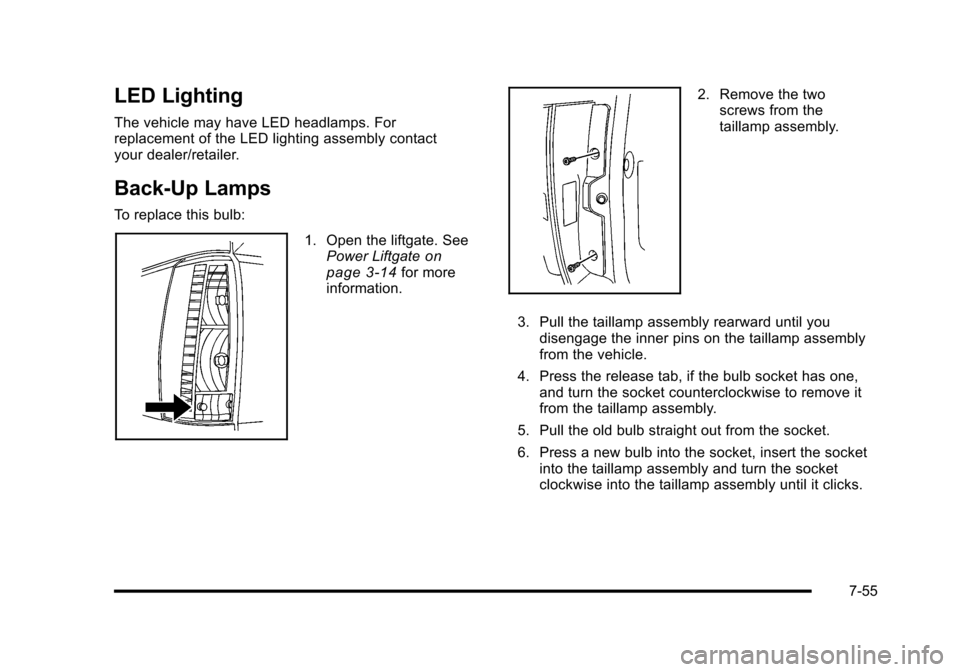
LED Lighting
The vehicle may have LED headlamps. Forreplacement of the LED lighting assembly contactyour dealer/retailer.
Back-Up Lamps
To replace this bulb:
1. Open the liftgate. SeePower Liftgateonpage 3!14for moreinformation.
2. Remove the twoscrews from thetaillamp assembly.
3. Pull the taillamp assembly rearward until youdisengage the inner pins on the taillamp assemblyfrom the vehicle.
4. Press the release tab, if the bulb socket has one,and turn the socket counterclockwise to remove itfrom the taillamp assembly.
5. Pull the old bulb straight out from the socket.
6. Press a new bulb into the socket, insert the socketinto the taillamp assembly and turn the socketclockwise into the taillamp assembly until it clicks.
7-55
Page 502 of 616
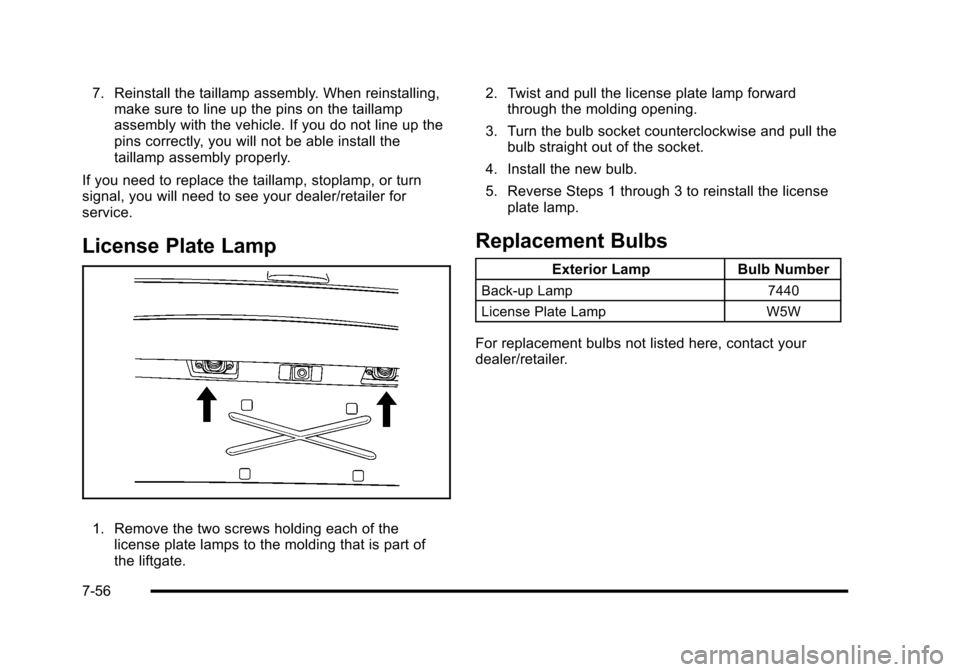
7. Reinstall the taillamp assembly. When reinstalling,make sure to line up the pins on the taillampassembly with the vehicle. If you do not line up thepins correctly, you will not be able install thetaillamp assembly properly.
If you need to replace the taillamp, stoplamp, or turnsignal, you will need to see your dealer/retailer forservice.
License Plate Lamp
1. Remove the two screws holding each of thelicense plate lamps to the molding that is part ofthe liftgate.
2. Twist and pull the license plate lamp forwardthrough the molding opening.
3. Turn the bulb socket counterclockwise and pull thebulb straight out of the socket.
4. Install the new bulb.
5. Reverse Steps 1 through 3 to reinstall the licenseplate lamp.
Replacement Bulbs
Exterior LampBulb Number
Back-up Lamp7440
License Plate LampW5W
For replacement bulbs not listed here, contact yourdealer/retailer.
7-56
Page 503 of 616
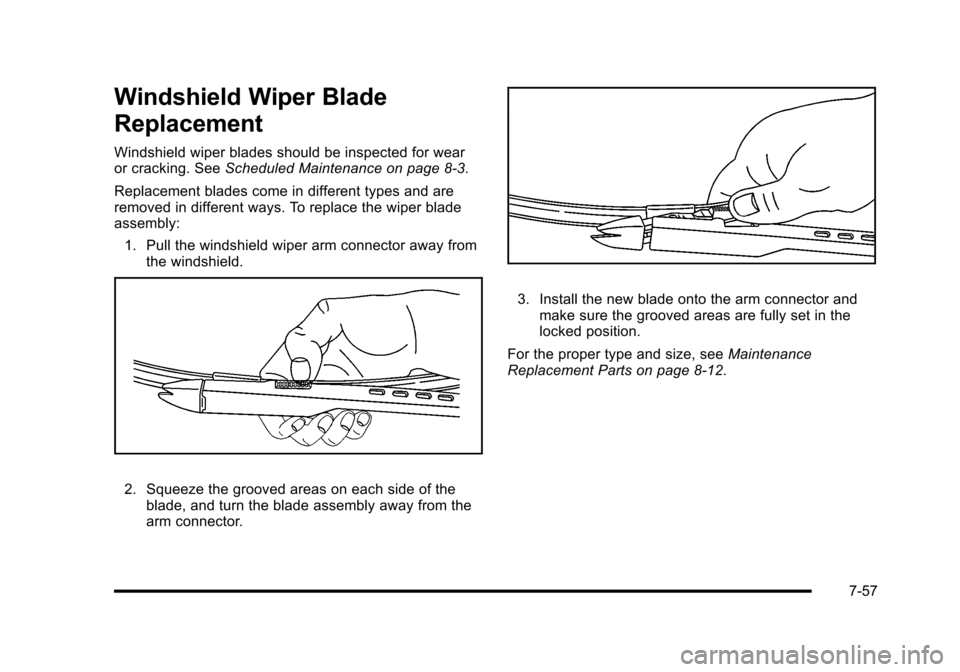
Windshield Wiper Blade
Replacement
Windshield wiper blades should be inspected for wearor cracking. SeeScheduled Maintenance on page 8!3.
Replacement blades come in different types and areremoved in different ways. To replace the wiper bladeassembly:
1. Pull the windshield wiper arm connector away fromthe windshield.
2. Squeeze the grooved areas on each side of theblade, and turn the blade assembly away from thearm connector.
3. Install the new blade onto the arm connector andmake sure the grooved areas are fully set in thelocked position.
For the proper type and size, seeMaintenanceReplacement Parts on page 8!12.
7-57
Page 504 of 616
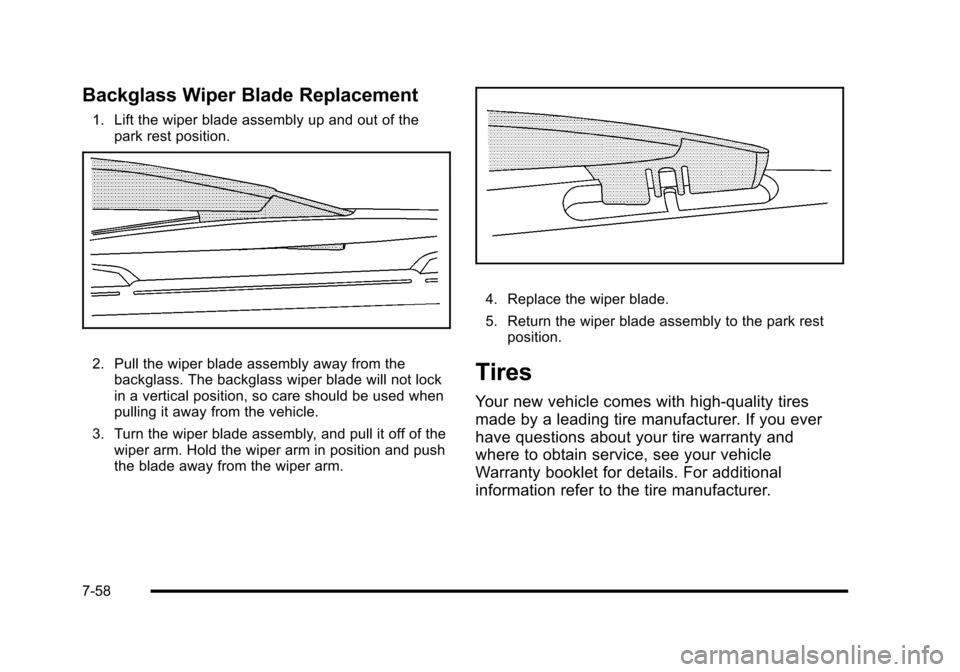
Backglass Wiper Blade Replacement
1. Lift the wiper blade assembly up and out of thepark rest position.
2. Pull the wiper blade assembly away from thebackglass. The backglass wiper blade will not lockin a vertical position, so care should be used whenpulling it away from the vehicle.
3. Turn the wiper blade assembly, and pull it off of thewiper arm. Hold the wiper arm in position and pushthe blade away from the wiper arm.
4. Replace the wiper blade.
5. Return the wiper blade assembly to the park restposition.
Tires
Your new vehicle comes with high-quality tires
made by a leading tire manufacturer. If you ever
have questions about your tire warranty and
where to obtain service, see your vehicle
Warranty booklet for details. For additional
information refer to the tire manufacturer.
7-58
Page 505 of 616
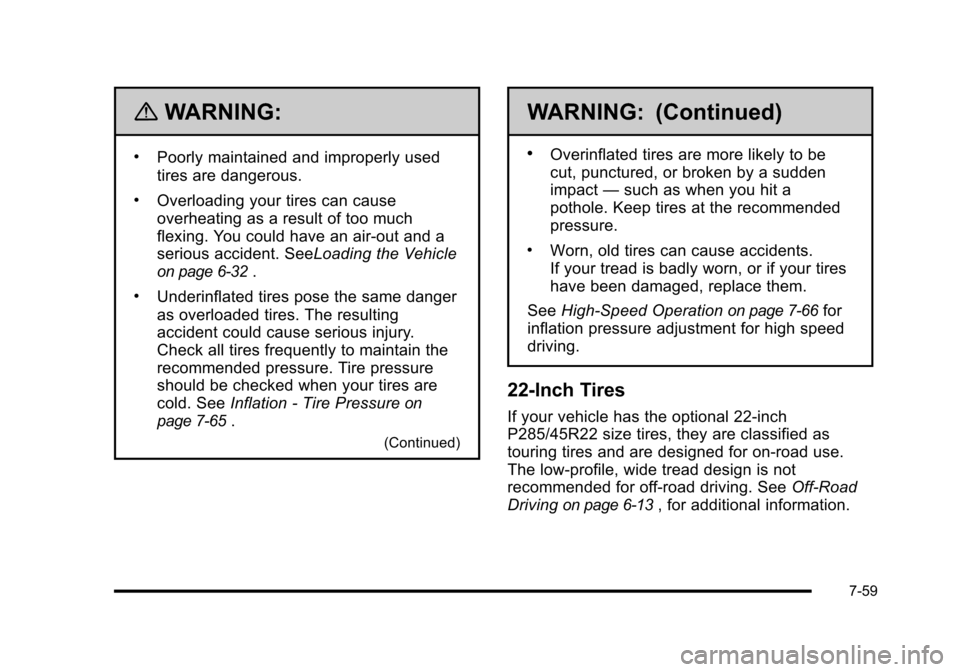
{WARNING:
.Poorly maintained and improperly used
tires are dangerous.
.Overloading your tires can cause
overheating as a result of too much
flexing. You could have an air-out and a
serious accident. SeeLoading the Vehicle
on page 6!32.
.Underinflated tires pose the same danger
as overloaded tires. The resulting
accident could cause serious injury.
Check all tires frequently to maintain the
recommended pressure. Tire pressure
should be checked when your tires are
cold. SeeInflation - Tire Pressureon
page 7!65.
(Continued)
WARNING: (Continued)
.Overinflated tires are more likely to be
cut, punctured, or broken by a sudden
impact—such as when you hit a
pothole. Keep tires at the recommended
pressure.
.Worn, old tires can cause accidents.
If your tread is badly worn, or if your tires
have been damaged, replace them.
SeeHigh-Speed Operationon page 7!66for
inflation pressure adjustment for high speed
driving.
22!Inch Tires
If your vehicle has the optional 22!inch
P285/45R22 size tires, they are classified as
touring tires and are designed for on!road use.
The low!profile, wide tread design is not
recommended for off!road driving. SeeOff-Road
Drivingon page 6!13, for additional information.
7-59
Page 506 of 616
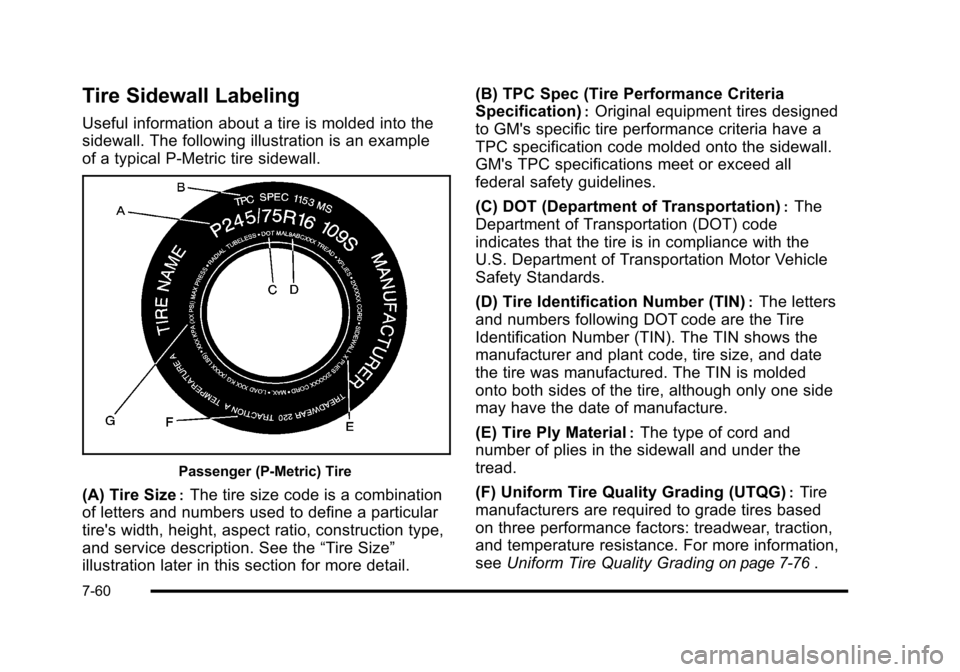
Tire Sidewall Labeling
Useful information about a tire is molded into the
sidewall. The following illustration is an example
of a typical P!Metric tire sidewall.
Passenger (P!Metric) Tire
(A) Tire Size:The tire size code is a combination
of letters and numbers used to define a particular
tire's width, height, aspect ratio, construction type,
and service description. See the“Tire Size”
illustration later in this section for more detail.
(B) TPC Spec (Tire Performance Criteria
Specification):Original equipment tires designed
to GM's specific tire performance criteria have a
TPC specification code molded onto the sidewall.
GM's TPC specifications meet or exceed all
federal safety guidelines.
(C) DOT (Department of Transportation):The
Department of Transportation (DOT) code
indicates that the tire is in compliance with the
U.S. Department of Transportation Motor Vehicle
Safety Standards.
(D) Tire Identification Number (TIN):The letters
and numbers following DOT code are the Tire
Identification Number (TIN). The TIN shows the
manufacturer and plant code, tire size, and date
the tire was manufactured. The TIN is molded
onto both sides of the tire, although only one side
may have the date of manufacture.
(E) Tire Ply Material:The type of cord and
number of plies in the sidewall and under the
tread.
(F) Uniform Tire Quality Grading (UTQG):Tire
manufacturers are required to grade tires based
on three performance factors: treadwear, traction,
and temperature resistance. For more information,
seeUniform Tire Quality Gradingon page 7!76.
7-60
Page 507 of 616
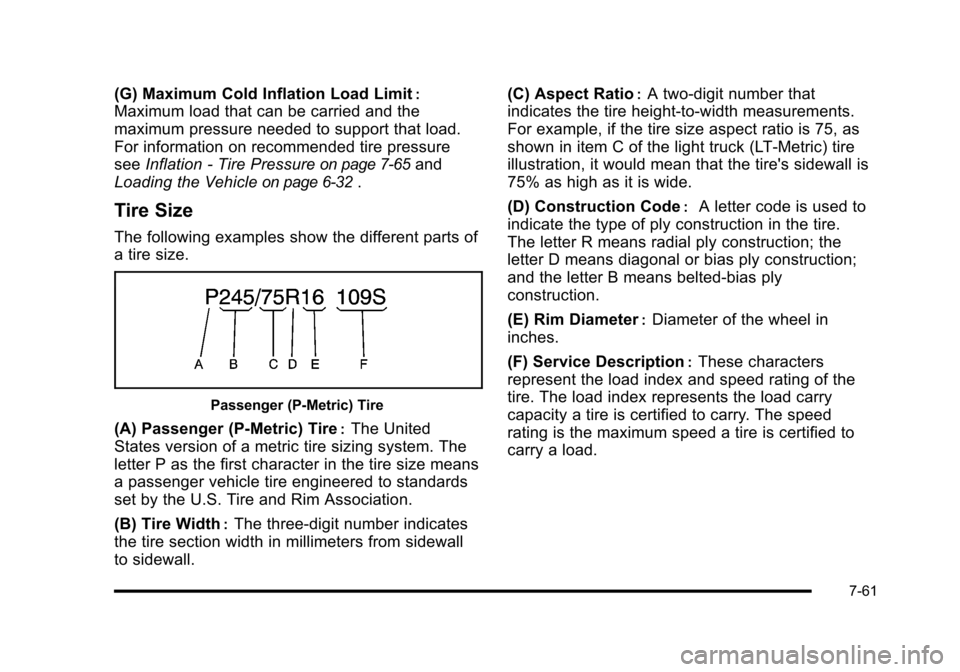
(G) Maximum Cold Inflation Load Limit:
Maximum load that can be carried and the
maximum pressure needed to support that load.
For information on recommended tire pressure
seeInflation - Tire Pressureon page 7!65and
Loading the Vehicleon page 6!32.
Tire Size
The following examples show the different parts of
a tire size.
Passenger (P!Metric) Tire
(A) Passenger (P!Metric) Tire:The United
States version of a metric tire sizing system. The
letter P as the first character in the tire size means
a passenger vehicle tire engineered to standards
set by the U.S. Tire and Rim Association.
(B) Tire Width:The three!digit number indicates
the tire section width in millimeters from sidewall
to sidewall.
(C) Aspect Ratio:A two!digit number that
indicates the tire height!to!width measurements.
For example, if the tire size aspect ratio is 75, as
shown in item C of the light truck (LT!Metric) tire
illustration, it would mean that the tire's sidewall is
75% as high as it is wide.
(D) Construction Code:A letter code is used to
indicate the type of ply construction in the tire.
The letter R means radial ply construction; the
letter D means diagonal or bias ply construction;
and the letter B means belted!bias ply
construction.
(E) Rim Diameter:Diameter of the wheel in
inches.
(F) Service Description:These characters
represent the load index and speed rating of the
tire. The load index represents the load carry
capacity a tire is certified to carry. The speed
rating is the maximum speed a tire is certified to
carry a load.
7-61
Page 508 of 616
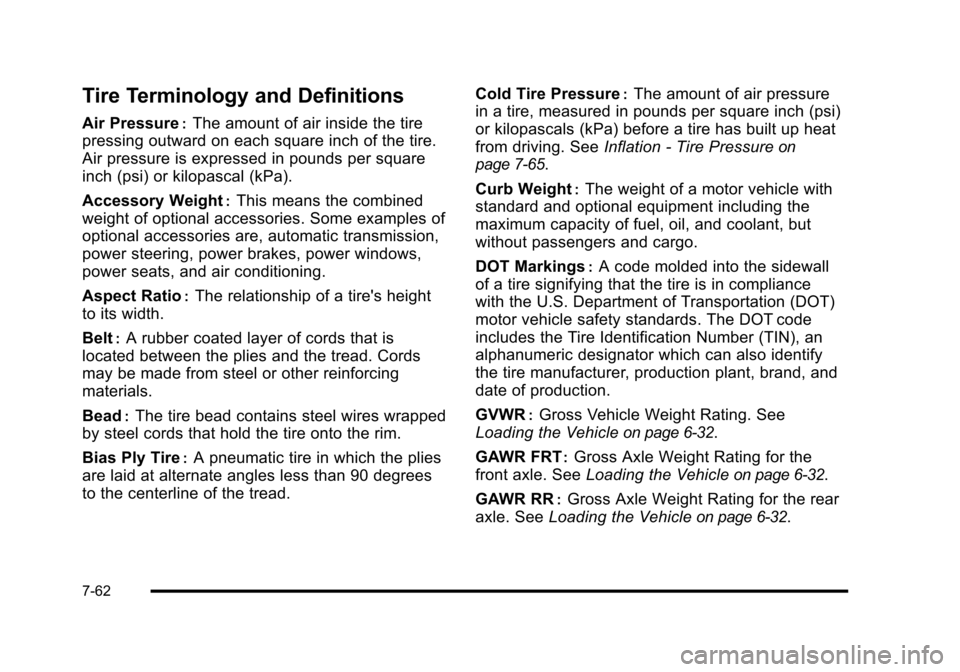
Tire Terminology and Definitions
Air Pressure:The amount of air inside the tire
pressing outward on each square inch of the tire.
Air pressure is expressed in pounds per square
inch (psi) or kilopascal (kPa).
Accessory Weight:This means the combined
weight of optional accessories. Some examples of
optional accessories are, automatic transmission,
power steering, power brakes, power windows,
power seats, and air conditioning.
Aspect Ratio:The relationship of a tire's height
to its width.
Belt:A rubber coated layer of cords that is
located between the plies and the tread. Cords
may be made from steel or other reinforcing
materials.
Bead:The tire bead contains steel wires wrapped
by steel cords that hold the tire onto the rim.
Bias Ply Tire:A pneumatic tire in which the plies
are laid at alternate angles less than 90 degrees
to the centerline of the tread.
Cold Tire Pressure:The amount of air pressure
in a tire, measured in pounds per square inch (psi)
or kilopascals (kPa) before a tire has built up heat
from driving. SeeInflation - Tire Pressureon
page 7!65.
Curb Weight:The weight of a motor vehicle with
standard and optional equipment including the
maximum capacity of fuel, oil, and coolant, but
without passengers and cargo.
DOT Markings:A code molded into the sidewall
of a tire signifying that the tire is in compliance
with the U.S. Department of Transportation (DOT)
motor vehicle safety standards. The DOT code
includes the Tire Identification Number (TIN), an
alphanumeric designator which can also identify
the tire manufacturer, production plant, brand, and
date of production.
GVWR:Gross Vehicle Weight Rating. See
Loading the Vehicleon page 6!32.
GAWR FRT:Gross Axle Weight Rating for the
front axle. SeeLoading the Vehicleon page 6!32.
GAWR RR:Gross Axle Weight Rating for the rear
axle. SeeLoading the Vehicleon page 6!32.
7-62
Page 509 of 616

Intended Outboard Sidewall:The side of an
asymmetrical tire, that must always face outward
when mounted on a vehicle.
Kilopascal (kPa):The metric unit for air
pressure.
Light Truck (LT!Metric) Tire:A tire used on light
duty trucks and some multipurpose passenger
vehicles.
Load Index:An assigned number ranging from
1 to 279 that corresponds to the load carrying
capacity of a tire.
Maximum Inflation Pressure:The maximum air
pressure to which a cold tire can be inflated. The
maximum air pressure is molded onto the
sidewall.
Maximum Load Rating:The load rating for a tire
at the maximum permissible inflation pressure for
that tire.
Maximum Loaded Vehicle Weight:The sum of
curb weight, accessory weight, vehicle capacity
weight, and production options weight.
Normal Occupant Weight:The number of
occupants a vehicle is designed to seat multiplied
by 150 lbs (68 kg). SeeLoading the Vehicleon
page 6!32.
Occupant Distribution:Designated seating
positions.
Outward Facing Sidewall:The side of an
asymmetrical tire that has a particular side that
faces outward when mounted on a vehicle. The
side of the tire that contains a whitewall, bears
white lettering, or bears manufacturer, brand,
and/or model name molding that is higher or
deeper than the same moldings on the other
sidewall of the tire.
Passenger (P-Metric) Tire:A tire used on
passenger cars and some light duty trucks and
multipurpose vehicles.
Recommended Inflation Pressure:Vehicle
manufacturer's recommended tire inflation
pressure as shown on the tire placard. See
Inflation - Tire Pressureon page 7!65andLoading
the Vehicleon page 6!32.
Radial Ply Tire:A pneumatic tire in which the ply
cords that extend to the beads are laid at
90 degrees to the centerline of the tread.
Rim:A metal support for a tire and upon which
the tire beads are seated.
Sidewall:The portion of a tire between the tread
and the bead.
7-63
Page 510 of 616

Speed Rating:An alphanumeric code assigned
to a tire indicating the maximum speed at which a
tire can operate.
Traction:The friction between the tire and the
road surface. The amount of grip provided.
Tread:The portion of a tire that comes into
contact with the road.
Treadwear Indicators:Narrow bands, sometimes
called wear bars, that show across the tread of a
tire when only 1/16 inch (1.6 mm) of tread
remains. SeeWhen It Is Time for New Tireson
page 7!73.
UTQGS (Uniform Tire Quality Grading
Standards):A tire information system that
provides consumers with ratings for a tire's
traction, temperature, and treadwear. Ratings are
determined by tire manufacturers using
government testing procedures. The ratings are
molded into the sidewall of the tire. SeeUniform
Tire Quality Gradingon page 7!76.
Vehicle Capacity Weight:The number of
designated seating positions multiplied by 150 lbs
(68 kg) plus the rated cargo load. SeeLoading the
Vehicleon page 6!32.
Vehicle Maximum Load on the Tire:Load on an
individual tire due to curb weight, accessory
weight, occupant weight, and cargo weight.
Vehicle Placard:A label permanently attached to
a vehicle showing the vehicle's capacity weight
and the original equipment tire size and
recommended inflation pressure. See“Tire and
Loading Information Label”underLoading the
Vehicleon page 6!32.
7-64